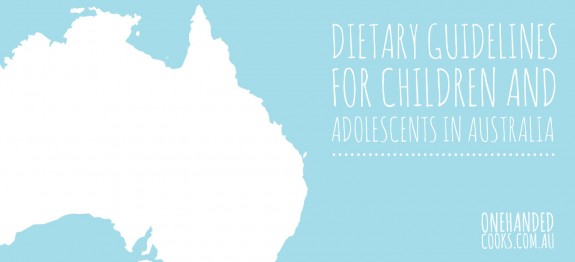Dietary Guidelines for Children & Adolescents in Australia
Healthy eating can be simple. It certainly shouldn’t be hard. And One Handed Cooks is all about bringing it back to basics, so we’d thought we’d share with you the Dietary Guidelines for Children & Adolescents in Australia. They apply to the general healthy population from birth to age 18. They do not apply to any child or adolescent that needs special dietary advice for a medical condition.
They were developed by the National Health & Medical Research Council (NH&MRC) in 1995, subsequently reviewed in 2003, are based on the best scientific evidence and research available. They are currently being reviewed in 2012 to ensure they reflect the latest information in health & nutrition.
The following guidelines promote health and wellbeing in your children and aim to reduce the risk of developing many diet-related (e.g. obesity, high cholesterol) and chronic diseases (e.g type 2 diabetes, cardiovascular disease) in later life.
Encourage and support breastfeeding.
Children and adolescents need sufficient nutritious foods to grow and develop normally.
- Growth should be checked regularly for young children
- Physical activity is important for all children and adolescents
Enjoy a wide variety of nutritious foods.
Children and adolescents should be encouraged to:
- Eat plenty of vegetables, legumes and fruits
- Eat plenty of cereals (including breads, rice, pasta and noodles), preferably wholegrain
- Include lean meat, fish, poultry and/or alternatives
- Reduced-fat milks are not suitable for young children under 2 years, because of their high energy needs, but reduced-fat varieties should be encouraged for older children and adolescents.
- Choose water as a drink
- Alcohol is not recommended for children
and care should be taken to:
- Limit saturated fat and moderate total fat intake
- Low fat diets are not suitable for infants.
- Choose foods low in salt
- Consume only moderate amounts of sugars and foods containing added sugars
Care for your child’s food: prepare and store it safely.




























